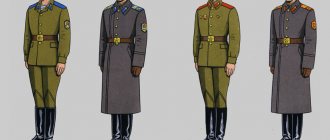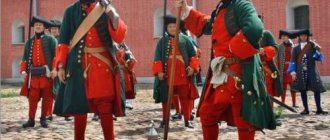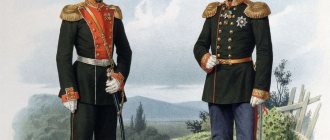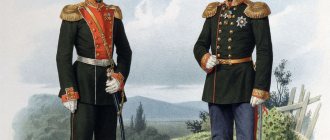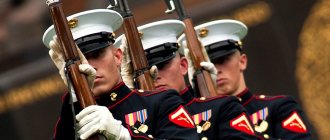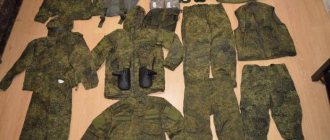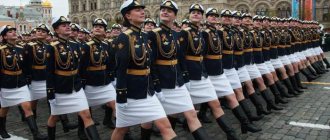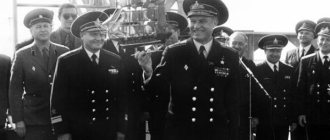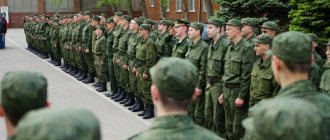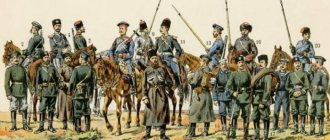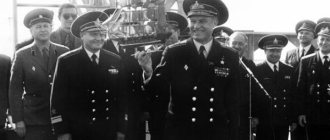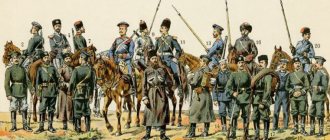On November 2, 1930, during an exercise in the Moscow Military District, twelve people were air-dropped as part of a special unit. It is this moment that is taken as the starting point of the history of our Airborne Forces. Throughout its existence, not only the status of the paratroopers changed more than once, but also their uniforms.
The uniform of our Airborne Forces received its current form relatively recently and has become a kind of calling card of one of the elite units of the Russian army.
New form of airborne forces in Russia
Now let’s travel through 2014 together with Russian Defense Minister Sergei Shoigu.
Not long ago he visited a legendary motorized rifle brigade, known since the Chechen war. In 2014, the soldiers of this unit were transferred to Ugra, and the new uniform acquired a new modern look, so now the military in such uniforms are not afraid of any frost. The new clothes were tested in extremely low temperatures, piercing and cold winds. Sergei Shoigu paid a visit to present awards, the action took place in an open area, and the military had to march in front of the highest leadership of Russia. At first, the form was delivered as an experimental one, but at the end of 2014 it was approved in 9 versions.
The new form for 2014 can be combined in different ways:
- for cool weather it will be enough to wear a lined jacket,
- for windy conditions it is recommended to wear a jacket under the jacket,
- in rainy weather, airborne special forces can wear a fleece shirt with a waterproof overall.
During the active training phase or the airborne assault march, the Airborne Forces wear their usual uniform. During theoretical classes, fighters wear lighter office attire.
The uniform of the Russian Airborne Forces in 2014 went through a number of changes: the ears on the earflap hat became longer, easily overlap at the back and are fastened with Velcro, this is quite important and comfortable for the chin. The hat has a top flap that can, if necessary, turn into a sun visor
Outerwear has also undergone many changes, for example, a jacket can be disassembled into several elements. It has become a kind of construction set that can be transformed from an ordinary windbreaker to a warm pea coat.
The entire 2014 field uniform consists of 16 pieces that easily fit into a backpack.
Depending on the time of year, the backpack can be light or heavy. In the new field footwear, felt boots were replaced by warm boots with inserts. A winter paratrooper vest has also been added, which does not restrict movement. A warm scarf and a comfortable balaclava were added to the whole set. Reconnaissance overalls are made of waterproof material.
What do modern paratroopers wear?
The shape of the new airborne forces is based on the principle of multi-layering. Depending on weather conditions, military personnel are allowed to combine clothing:
- the modern uniform of the Russian Airborne Forces includes several combinations and sets of diverse clothing;
- in the cool season, soldiers are provided with an additional lined jacket;
- often military personnel from the special forces of the Airborne Forces are allowed to wear a jacket under their jacket;
- in rainy, damp weather, the uniform consists of an underwear fleece shirt and overalls with waterproof impregnation.
Thus, what uniform the airborne soldiers will have in a particular case is decided independently by the unit commander, taking into account weather conditions.
Additionally, the hat is equipped with a top flap, allowing it to turn inside out and transform into a visor. Felt boots were replaced with warm boots with thermal inserts. The outer jacket is a designer one and can easily be transformed from a windbreaker into a warm peacoat.
The new uniform set of the Russian Airborne Forces uniform for soldiers and field officers includes 19 items:
- several jackets;
- insulated vest;
- costume;
- three types of boots (summer, demi-season and winter);
- balaclava;
- mittens and gloves.
The summer uniform of the airborne special forces includes:
- underwear (T-shirt and boxer shorts);
- light jacket;
- trousers;
- cap (beret);
- summer boots.
To sew a lightweight version of the airborne uniform, a mechanical stretch treated with a water-repellent compound is used.
Winter uniform for the Airborne Forces option includes:
- two sets of insulated underwear (lightweight and fleece);
- demi-season suit;
- windproof suit;
- insulated vest;
- boots;
- balaclava.
In winter, it is allowed to wear a blue sweater under a jacket that is part of the uniform.
For hot climates, a separate set of uniforms for airborne troops was developed. The new uniform of airborne troops has a light brown or sandy color.
The first option consists of a short-sleeved shirt with a turn-down collar, shoulder straps, trousers and boots in a basic color. The headgear used is a soft cap similar to a baseball cap with a hard visor and a field cockade.
Shorts are allowed instead of trousers. Insignia on this type of uniform are placed similarly to everyday uniforms. This clothing option does not include award stripes. The second option consists of an elongated jacket with shoulder straps, trousers tucked into ankle boots. On the head is a cap or Panama hat that matches the statutory uniform.
The field uniform of an officer is exactly the same as that of the enlisted personnel of the Airborne Forces, only the dress clothes are different.
The ceremonial set of the Airborne Forces uniform consists of a blue jacket and trousers, a vest, a blue beret, aiguillette, white gloves and ankle boots.
Officer ceremonial uniform:
- blue jacket;
- untucked blue trousers;
- shirt;
- black tie;
- White gloves;
- black boots;
- gold aiguillette;
- blue cap with cockade.
The winter dress uniform of midshipmen and airborne officers includes a black jacket, a woolen cap or blue beret, a vest and combat boots. For enlisted personnel and cadets:
- gray hats with earflaps;
- demi-season blue jacket;
- costume;
- vest;
- beret.
Airborne special forces take part in the parade in field uniform. Not only shoulder straps, but also breast and sleeve stripes and chevrons are used as insignia. Before the collapse of the Soviet Union, the uniform was identical for all Airborne Forces employees, regardless of the republic.
Today, each country that was part of the USSR has its own version of the uniform. In the Russian Federation, the main ceremonial color of the Airborne Forces uniform is blue.
For example, not so long ago, the uniform of the highly mobile Ukrainian Airborne Forces was completely changed, in particular, the blue beret was removed from the military personnel’s clothing, replacing it with a similar purple-colored headdress. The main reason for this transformation is that in Russia the blue beret is an integral part of the Airborne Forces uniform.
In turn, in the Republic of Belarus the uniform of the special forces of the airborne special forces still includes a blue beret, as in Russia.
All products by tags
Related Products
Trousers from a special suit of parachute parts With buttons The belt is adjustable in size using side elastic bands High waistband for the convenience of carrying ammunition on a belt Belt loops for a wide waist belt Reinforcing lining with a softening insert on the knees (photo A) Mesh for ventilation in the groin area Bottom of the trousers with an elastic band The cuffs at the bottom of the trousers are cinched with tape, which prevents debris from getting into the shoes Pockets: 2 side pockets and 2 hip pockets with a folded top, which prevents items from spontaneously falling out 1 knife pocket 2 back pockets Material: 100% cotton YOU MAY BE INTERESTED IN: Designed for parachute parts of the suit turned out to be very convenient for tourists. Everything that is suitable for a parachute is also good for a backpack. Durable, heavy duty canvas fabric, pre-shrunk and highly fade resistant. The tarpaulin breathes, protects from wind and moisture, is not afraid of a fire (if you do not dry clothes on a fire rope) and is not bitten by insects. The loose-fitting jacket does not restrict movement and has no protruding parts. Due to the absence of lower pockets, it can be worn either untucked or tucked into trousers. Buttons characteristic of uniforms. The bottom of the jacket is adjustable in size. Two front pockets and easy-to-access side sleeve pockets are secured with flaps. The internal pocket for documents is made of water-repellent fabric. Ventilation in the most overheated areas of the jacket and trousers is provided by mesh fabric. The most tense ones (elbows and knees) are reinforced with additional pads (on the knees with a softening insert). Pants with a high, adjustable elastic waistband and straps for a wide belt are comfortable and allow you to carry the necessary equipment on the belt. The loose cut and drawstring bottom of the legs allow you to move freely through the most inaccessible places and protect the boots from debris getting inside. The restraint of the jacket is more than compensated by the abundance of pockets on the trousers. Slit pockets on the sides are simple and familiar, two back pockets with flaps, two front pockets with flaps on the front of the hips and a pocket for a knife. You can place everything you need from salt, matches, maps, compass and GPS to machine gun horns. A durable, comfortable, breathable, unpretentious suit will provide reliable protection in the forest and in the air.
MPA-78 Light jacket provides excellent protection from wind, thanks to the stitched lining, removable hood and windproof strip. On the right and left shelves there are patch pockets fastened with textile fasteners. There are also front side welt pockets with a zipper. The sleeves are adjustable in width using tape and plastic patches (Velcro). Along the shoulder line there are false shoulder straps fastened with buttons. On the left side of the jacket lining there is a horizontal zippered pocket. The demi-season jacket of the Ministry of Defense provides excellent protection from wind thanks to the stitched lining, removable hood and windproof flap. On the right and left shelves there are patch pockets fastened with textile fasteners. Appearance. Jacket of a straight silhouette with an insulated stitched lining, with a central side zipper, with an external wind flap, and a drawstring at the waist. The front has a stitched yoke extending to the back, with upper welt pockets with flaps fastened with textile fasteners, side welt pockets fastened with a zipper. Set-in two-seam sleeves with stitched cuffs on an elastic band and plastic patches (Velcro) at the bottom to adjust the width. Along the shoulder line there are shoulder straps with false shoulder straps, fastened with buttons. Stand collar. The hood is fastened with a zipper, consisting of three parts. The hood along the front neckline is adjustable with an elastic cord and clamps. On the left side of the jacket lining there is a horizontal zippered pocket. Characteristics protection from cold protection from rain and wind regular cut Materials rip-stop membrane
On November 2, 1930, during an exercise in the Moscow Military District, twelve people were air-dropped as part of a special unit. It is this moment that is taken as the starting point of the history of our Airborne Forces. Throughout its existence, not only the status of the paratroopers changed more than once, but also their uniforms.
The uniform of our Airborne Forces received its current form relatively recently and has become a kind of calling card of one of the elite units of the Russian army.
Summer option
The ceremonial version of the uniform of military personnel of the Russian Aerospace Forces, for cadets and enlisted personnel, of the summer type is a suit. It can be blue or khaki. Under his tunic, a private is required to wear a shirt of the same color, complemented by a tie with a gold tack. Officers are expected to wear a jacket and trousers of the same colors in combination with a white shirt and black tie. The cap of a VKS serviceman must be matched to the color of the suit. The set should include a gold belt.
The field version of the uniform for privates and cadets of the VKS, abbreviated as VKPO, is no different from the uniform version for the ground forces. The kit should include the following clothing items:
- short sleeve underwear;
- jacket with trousers;
- summer boots;
- cap;
- nude summer T-shirt.
Find out: What military ranks were there in the USSR army, what shoulder straps did the soldiers wear?
The office uniform for military personnel of the Russian Aerospace Forces differs in color from the uniform of other branches of the military. For military personnel of the military space forces it is blue. Otherwise, in style and details, it is similar to the uniform of other troops. Stripes and shoulder straps are issued in accordance with the serviceman's type of troops and his ranks.
Stowing the RD-54 backpack
Various equipment and equipment can be stowed in the RD (paratrooper's backpack). Let's look at the most common type of installation.
Find out: How to properly sew and attach shoulder straps to a shirt
- We pack a bag with a gas mask. To do this, you need to unfasten the backpack and put the bag with the gas mask inside.
- The bag contains 4 Kalashnikov assault rifle magazines.
- Smoke bombs are placed in the side compartments.
- The left side compartment can accommodate a cape.
- Finally, the backpack should be laced and zipped.
- We place 2 magazines for the machine gun in the pouch.
- Grenades are placed in a separate grenade pouch. Before landing, the grenades and fuse are placed in different compartments in it.
- A sapper shovel is placed in a special pouch. It is turned with the concave side towards the body and placed in a special compartment for it.
In order to collect all the necessary pouches, use a belt. First, a bayonet-knife in a holster is threaded into it, and then all the parts of the RD-54 system are placed one by one. Each pouch has loops so that it can be easily attached to a belt.
An interesting feature of this backpack is the ability to throw it over your head and get the necessary item. To do this, you need to unfasten the side carabiners and throw it over your head. Take out the necessary items and, without unfastening, return it to its previous position.
Dembel uniform
The tradition of leaving for demobilization in a special uniform dates back to the times of the Soviet Union. This form was prepared in advance, six months in advance. Now you can order it on certain websites on the Internet. The uniform is decorated with all sorts of additions, such as aiguillettes, insignia, and rivets. There is also a demobilization version of the VKS uniform; it has its own characteristics. Any demobilization is of two types, strict and exclusive. The difference between them is the degree of finishing with various accessories.
Find out: The rank of captain of the Navy, what the first, second and third ranks mean
The demobilization form of the VKS may include the following details:
Since the founding of this type of troops, the uniform of the Airborne Forces was no different from the clothing of the Red Army Air Force or special purpose air battalions. The set of clothes for a USSR intelligence soldier included:
- Leather or blue-gray canvas helmet.
- Moleskin overalls (could be either leather or blue-gray canvas).
- The collar of the overalls was equipped with blue buttonholes, where insignia were sewn.
Already in the forties, the military uniform for aerial reconnaissance was changed to avisent jackets with trousers. The pants had huge patch pockets. The winter clothes of the USSR paratroopers were insulated with sheepskin uniforms: a brown or dark blue fur collar, which was fastened with a zipper.
The military clothing of the forces was divided into 4 groups:
- summer uniform for every day for sergeants and soldiers;
- summer casual clothing for sergeants, airborne cadets, soldiers;
- summer casual clothing of cadets, where buttonholes and shoulder straps indicated the branch of service;
- winter clothing for sergeants, cadets, military builders, where buttonholes, shoulder straps and a badge on the sleeve are according to the branch of service.
In addition, the military uniform in the USSR had to take into account the climatic features of the area where the troops were located. For example, in the Finnish war, a soldier’s winter clothing was supplemented with:
- hats with earflaps,
- padded jackets,
- cotton pants,
- white camouflage robes and hoods.
The rest of the military clothing in the USSR, for example, for rifle units, looked like a simple budenovka and boots. In addition to their canvas helmets, the paratroopers had large goggles for pilots. This attribute was issued due to the fact that they often had to parachute. If you take a close look at the photo or film materials of those times, you can see that even ceremonial clothing could consist of helmets and glasses, and a parachute jumpsuit.
The military uniform of a USSR officer had a cap with a chin strap for parachute jumping; ordinary Red Army soldiers hid their caps in their bosoms. There were no special shoes for jumping, so felt boots often fell off the feet when the parachute opened. Officer's shoes also presupposed the existence of fur boots.
The usual uniform of the Airborne Forces in Russia differed from other troops only in blue buttonholes; officers had gold trim around them. The piping on the buttonholes of political workers, sergeants or privates was black; this was considered a kind of office option. Officers were also distinguished by blue piping on the collar and the upper edge of the cuffs, and side stitched seams on the riding breeches. Caps with blue piping and red stars or dark blue caps with red enamel stars - all this was typical for the leadership of the Airborne Forces.
During the existence of the Soviet Union, the Ukrainian Airborne Forces were no different in their military uniform from the Russian troops; one single template was in effect throughout the entire USSR. After the collapse of the state, Ukraine had to “redraw” not only the meaning of the type of troops itself, but also the form of intelligence. Until recently, the airborne forces of these two countries could only be distinguished by different stripes, which depicted the coats of arms of different countries. Ukraine's uniform depicts a trident on a yellow-blue background.
From the history of blue berets
This fashion reached the Soviet Union only in the 60s. Interestingly, the Marines were the first to wear this headdress. Berets appeared in the Airborne Forces in 1967. Few people know that the original berets were not blue, but crimson. Although the color blue was available in the landing uniform even then (edgings and shoulder straps). The crimson color of the berets was proposed by the artist Zhuk, who borrowed this color from paratroopers of other countries.
The crimson color was not the only one. The artist demonstrated two versions of color schemes to General Margelov. In addition to crimson, there was also a protective color. Berets of this color were planned to be worn as everyday wear, although this remained just a project. Raspberry berets seemed to “Uncle Vasya” more suitable for parades, but he did not approve the everyday version.
In 1967, airborne troops were given the chance to appear at the parade in crimson berets. However, the paratroopers did not wear this color of berets for long. For unknown reasons, the high command decided to change the color of the berets. It is possible that official party leaders were suspicious of the crimson color, and perhaps did not want to have anything to do with the color of the berets of the airborne forces of capitalist countries.
In addition, there is another version that says that the blue color is associated with the sky, which in turn could be most suitable for paratroopers. In general, there is no exact information about the reasons for such sudden changes in the color of the beret.
In 1969, the color was changed to the one seen today, blue. In addition, there was no casual and formal version of berets, which could differ in color.
Outdated samples of Airborne Forces uniforms
The winter uniform of an Airborne Forces officer used to be equipped with a dark blue double-breasted overcoat, then the color was changed to regular gray and ear flaps. The field clothing of the troops did not differ from other units at the time of the war, so in winter everyone wore white camouflage overalls, and in summer the colors changed to camouflage.
The paratroopers were given special uniforms immediately before the landing; later the uniform was replaced with a regular one, one might say, office uniform, and the special forces clothing was confiscated. As soon as shoulder straps were introduced, the Airborne Forces began wearing aviation insignia. For privates and sergeants, blue shoulder straps with black edging were introduced, and the stripes were brick-red. The dress uniform has always been distinguished by a blue edging, and the caps have a blue band. The same form was characteristic of the Ukrainian Airborne Forces at the time of being part of the USSR and military operations on one side.
Where did you serve?
On this issue, real paratroopers identify impostors with a very high probability.
Answers like: “I served in the Pskov division” are not suitable here. A fighter of this illustrious formation should know its full name - the 76th Guards Air Assault Chernigov Red Banner Division. Types of Russian special forces. INFOGRAPHICS A paratrooper must always know the full name of the unit in which he served in the division, with all its regalia. For example, the 234th Guards Air Assault Black Sea Order of Kutuzov Regiment named after the Holy Blessed Alexander Nevsky.
Without hesitation, soldiers must know the battalion, company and platoon where they served. And also remember your commanders. Real airborne veterans don’t forget this.
Features of the old-style Airborne Forces dress uniform
For special occasions, the air infantry was provided with a ceremonial set of uniforms, presented in summer and winter versions. In 1988, it underwent a number of changes.
Old style summer dress uniform:
- cap with band;
- untucked trousers;
- open uniform;
- White shirt;
- black tie;
- White gloves;
- black low shoes or boots.
The ceremonial set of the summer uniform had a blue (sea) wave color.
The ceremonial winter uniform of an old-style Airborne Forces soldier:
- hat with ear flaps, lieutenant colonels have a hat;
- gray overcoat;
- open uniform;
- untucked blue trousers;
- White shirt;
- black tie;
- white muffler;
- brown gloves;
- black boots.
Since 1967, the beret has become part of the ceremonial set of clothing, replacing the cap.
Hats
Since 1938, a dark blue cap was approved as a headdress for command personnel. In 1941, it was replaced by a similar product, but in a protective green color. The band of the cap, its rim and the crown part were equipped with a blue edging. The cap was also replenished with a cockade with a red star surrounded by a laurel wreath. These stars on the cockade of headdresses have been preserved in the modern uniform of the Airborne Forces. The privates wore dark blue caps with blue piping and cloth stars, on which red enamel stars were attached on top. During the landing, commanders used caps equipped with special straps. Soldiers' caps were simply removed from the head.
What is a birch pattern
Camouflage is a mandatory part of the equipment of the military and, in particular, the reconnaissance troops of the Airborne Forces. The range of camouflage suits is wide, which allows you to choose the ideal camouflage for any climatic and weather conditions. Despite this, the leader of camouflage clothing until recently was the birch (official name KZM-P).
Initially, camouflage with a birch tree pattern was developed for border troops; later it was liked by airborne reconnaissance officers.
A camouflage suit with a birch pattern was created in 1957 and was used as part of the summer equipment of border guards and paratroopers. This camouflage ideally hid the fighter in deciduous forests and swampy areas. Due to its special pixel pattern, KZM-P is capable of dispersing the silhouette of a person at short and long distances.
The raster pattern of the birch camouflage suit resembles spots with jagged edges. Large and small patterns create an optical illusion of a melting silhouette. The light and dark colors of the camouflage coat suggest its use during the day and at night.
Although today the birch camouflage is not a statutory uniform, it is still popular, not only among the military, but also among civilians.
Camouflage in service
Camouflage is found quite often not only in military, but also in civilian life, as it is very convenient and practical. But they appeared among employees in the Airborne Forces relatively recently, only towards the end of the Afghan War of 1987-1988. While, for example, Americans have long understood the reliability of this much-needed attribute.
But modern troops still do not have a single camouflage pattern; its types change from unit to unit, somewhere they use newer models, somewhere they haunt the 1994 designs. But here we should complain only about the supply, or, more precisely, about its insufficiency.
The demobilization uniform is strict
Of course, this article would be incomplete without a brief description of how to make a demobilization uniform. However, there is a nuance here. After all, by and large, there are two types of such clothing:
- strict form of demobilization;
- demobilization uniform is exclusive.
Which one is preferable? There is no single answer here. Of course, this is a matter of demobilization taste. However, if the retiree has a sense of style, then we would recommend the first option. It is more restrained; it provides for individual modifications to the standard soldier's uniform, verified in practice over many generations of demobilization.
This is, for example, the classic demobilization form of air defense. We list the improvements to the strict form of demobilization:
- tunic and trousers tailored to fit in the studio (if necessary);
- an additional chevron of the military branch sewn onto the jacket;
- inserts under the shoulder straps of the jacket (the latter retain their flat shape and decorate the contour of the shoulder);
- homemade shoulder straps for a shirt (they are not provided for in the form, but craftsmen make them to their liking);
- modified shape of the “aerodrome” cap (achieved by increasing the ribbon spring inserted into the rim);
- standard military badges of the branch of service, class, sports categories, etc., arranged in the prescribed order.
By the way, according to experts, the naval demobilization uniform looks especially spectacular. Below we will tell you more about it.
Distinctive features of the field uniform
Soviet paratroopers had two options for clothing for field conditions: summer and winter. The summer field uniform set included:
- cap;
- jacket and trousers in khaki colors;
- vest;
- boots or high boots.
Description of the winter uniform of the Airborne Forces:
- hats with earflaps;
- khaki jacket and pants;
- gray muffler;
- brown gloves;
- berets or boots.
The entry of Soviet troops into Afghanistan required the leadership to reconsider the equipment of employees. The classic field uniform is being replaced by a lighter version, popularly called Mabuta after the colonel of the Congolese army. It was made of raincoat fabric with water-repellent impregnation, a ventilation system and a more comfortable cut.
The sand uniform consisted of trousers, a jacket and a cap and was used during combat missions in regions with a hot climate.
What kind of demobilization uniform do paratroopers have?
The tradition of sewing a demobilization outfit comes from the Soviet Union, when military service was considered honorable. DMB is a kind of confirmation that the soldier served well and is proud of his army uniform. What can we say about the guys who paid their debt to the Motherland in the ranks of the Airborne Forces.
And although in the early 90s they preferred to go into the reserves in civilian clothes, today military personnel have returned to this beautiful custom.
The demobilization uniform of an Airborne Forces soldier is prepared on the basis of a field uniform using several rules:
- the suit should not be pretentious or overly elegant;
- placement of insignia and external chevrons is carried out in accordance with the statutory rules.
For the layout of the suit, an acanthus tunic or “gorka” can be used, which is often chosen by airborne special forces, trousers, a vest and combat boots. A mandatory attribute of the finished outfit is a blue beret.
It is an honor to serve in the airborne forces and many guys would like to be in the ranks of the blue berets. But this honor is not granted to everyone, which does not prevent civilians from trying on the paratrooper uniform.
Today there are not only adult, but also children's airborne uniforms on sale. Why do civilians wear military uniforms at events dedicated to the celebration of victory and other celebrations? Everyone has their own reasons for this. For example, children's military uniforms of the Airborne Forces are popular during the celebration of Victory Day.
On the other hand, as boxer Denis Lebedev explained, this shows respect for the paratroopers. It's hard to disagree with the athlete; they really deserve respect.
Video
Clothing and equipment of airborne groups must meet basic requirements; it must not only be comfortable, but also ensure the accomplishment of assigned combat missions.
First of all, the equipment should:
- do not hinder movement;
- ensure life activities;
- meet all reliability parameters.
The equipment of a paratrooper depends on the tasks facing him. The airborne troops are staffed with fighters of various types. Mostly, flamethrowers, snipers, machine gunners, machine gunners and sappers serve in airborne units. Depending on their military specialty, each soldier has his own combat equipment.
In addition to the basic attributes of a paratrooper, a flamethrower's mandatory equipment set includes a light flamethrower. A machine gunner cannot do without a weapon capable of providing a barrage of fire and stopping the enemy. Sappers are equipped with new mine detectors that can detect shells even behind a concrete wall.
Uniform requirements
- At the moment, the uniform of the Russian Airborne Forces involves several sets and combinations of diverse clothing (not only of a combat nature).
- In cool weather conditions, a lined jacket is added for soldiers.
- Often the military resorts to using a sweater under a jacket.
- When the weather is quite humid, damp and rainy, you can wear a fleece undershirt and a waterproof overall.
- During active service, military personnel wear personal uniform. When the conditions for a military man are related to theoretical training, the military can be in mild shape.
It is also worth noting that such a conservative version of clothing is constantly undergoing new and more effective changes. Every time the creators provide an almost perfect uniform. However, time passes, more and more new knowledge is accumulated, equipment and technology are developing.
Depending on personal preferences, as well as weather conditions, the military themselves will select the combination of uniforms they need.
All this, one way or another, has a direct impact on the continued improvement of uniforms for soldiers in general and special units in particular, which are the Airborne Forces. It is no coincidence that last year was marked as another chronological starting point for the new model of the Airborne Forces uniform, with regular changes and innovations...
Today, the uniform of an Airborne Forces soldier has earflaps with long ears, which overlap without problems and are fastened with a special Velcro, which makes it possible to more effectively cope with the protection of the chin. The earflaps have a top flap, with the ability to turn inside out and transform into a visor that protects from the sun.
A sufficient number of changes also affected the outerwear of the Airborne Forces. A modern landing jacket can be roughly disassembled into a couple of parts. Now she has the opportunity to transform into a warm pea coat.
There is also a field uniform for an Airborne Forces soldier, the number of elements of which is already greater, namely, it consists of 16 items of clothing that easily fit in a compact combat backpack. However, you should not focus on weight, since in warm weather the weight of the backpack increases significantly, and in cold weather it decreases, and sharply.
The felt boots have been completely replaced with new insulated boots with thermal inserts. The insulated version of the field uniform today has a vest, which, to the delight of the fighters, in no way restricts movement during moments of physical activity. In addition, we must not forget about a special scarf-front that protects from the wind, as well as a comfortable balaclava. The overalls itself and all its components are made in a waterproof version.
There is also a dress uniform and a demobilization uniform for a soldier who has served his military service in the Airborne Forces. See the photo to see what the ceremonial and demobilization uniforms look like.
There are no exceptions to the rules for female military personnel. The only difference is the presence of a skirt in the formal version.
Material
Since paratroopers conduct training and carry out combat missions in heat, frost or rain, the airborne uniform must be comfortable at any time of the year and in any weather and climatic conditions.
For the manufacture of the new-style Airborne Force uniform, high-quality material is used - polymer ripstop, which is supplied by Russian manufacturers. Cotton-polymer fabric (ratio: 65% to 35%) is made from reinforced thread using the latest advances in nanotechnology. Due to the strengthened weaving structure, Russian manufacturers managed to achieve high strength and wear resistance of the fabric without increasing its weight. According to reviews from military personnel, the fabric “breathes” easily and dries quickly.
Air force demobilization uniform
The Air Force demobilization uniform is made on the basis of the field uniform. It can be purchased online by sending your measurements to the manufacturer: height, chest circumference, waist circumference, sleeve length, headdress size. The purchase is made by 100% payment, 50% prepayment and interest-free installments.
The kit of the purchased uniform includes a jacket, “modified” with blue velvet shoulder straps or chevrons attached using semi-rigid relief linings, as well as a blue improved beret.
However, the Air Force demobilization uniform can be made independently. To do this, the serviceman must purchase a set of field uniforms made from digital fabric and modify it. You will need to spend money on purchasing additional chevrons and aiguillettes at the military store. Specific flight badges and insignia should be obtained. Blue velvet is bought in a civilian retail chain.
There is one auxiliary detail for giving the ideal shape to shoulder straps, chevrons, and stripes. It is made by hand from cellophane and white fabric. This is a semi-rigid lining. To make it you need a minimum of materials: cellophane and a piece of old bleached sheet. The tools you will need are a hot iron and scissors.
The technology is simple: two layers of fabric are glued together using cellophane using a hot iron. This is followed by another layer of cellophane, fabric, etc. The product is simple, but the shoulder straps and chevrons sewn with it are not visually lost, they are accentuated and look prominent.
